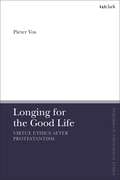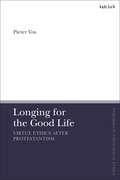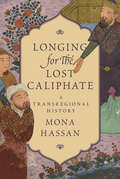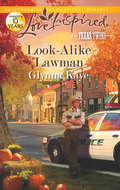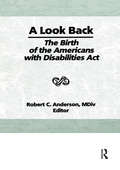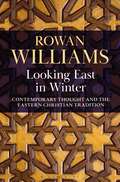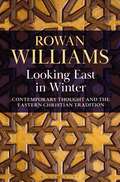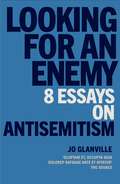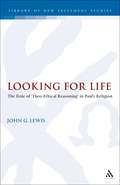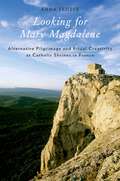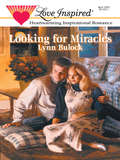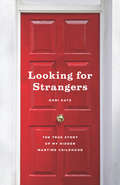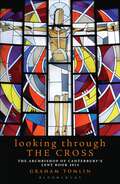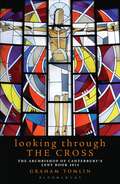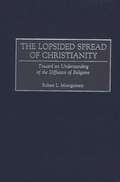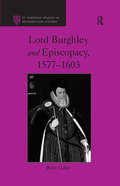- Table View
- List View
Longing for the Good Life: Virtue Ethics After Protestantism (T&T Clark Enquiries in Theological Ethics)
by Pieter VosThis book argues that Protestant theological ethics not only reveals basic virtue ethical characteristics, but also contributes significantly to a viable contemporary virtue ethics. Pieter Vos demonstrates that post-Reformation theological ethics still understands the good in terms of the good life, takes virtues as necessary for living the good life and considers human nature as a source of moral knowledge. Vos approaches Protestant theology as an important bridge between pre-modern virtue ethics, shaped by Aristotle and transformed by Augustine of Hippo, and late modern understandings of morality. The volume covers a range of topics, going from eudaimonism and Calvinist ethics to Reformed scholastic virtue ethics and character formation in the work of Søren Kierkegaard. The author shows how Protestantism has articulated other-centered virtues from a theology of grace, affirmed ordinary life and emphasized the need of transformation of this life and its orders. Engaging with philosophy of the art of living, Neo-Aristotelianism and exemplarist ethics, he develops constructive contributions to a contemporary virtue ethics.
Longing for the Good Life: Virtue Ethics after Protestantism (T&T Clark Enquiries in Theological Ethics)
by Pieter VosThis book argues that Protestant theological ethics not only reveals basic virtue ethical characteristics, but also contributes significantly to a viable contemporary virtue ethics. Pieter Vos demonstrates that post-Reformation theological ethics still understands the good in terms of the good life, takes virtues as necessary for living the good life and considers human nature as a source of moral knowledge. Vos approaches Protestant theology as an important bridge between pre-modern virtue ethics, shaped by Aristotle and transformed by Augustine of Hippo, and late modern understandings of morality. The volume covers a range of topics, going from eudaimonism and Calvinist ethics to Reformed scholastic virtue ethics and character formation in the work of Søren Kierkegaard. The author shows how Protestantism has articulated other-centered virtues from a theology of grace, affirmed ordinary life and emphasized the need of transformation of this life and its orders. Engaging with philosophy of the art of living, Neo-Aristotelianism and exemplarist ethics, he develops constructive contributions to a contemporary virtue ethics.
Longing for the Lost Caliphate: A Transregional History
by Mona HassanIn the United States and Europe, the word "caliphate" has conjured historically romantic and increasingly pernicious associations. Yet the caliphate's significance in Islamic history and Muslim culture remains poorly understood. This book explores the myriad meanings of the caliphate for Muslims around the world through the analytical lens of two key moments of loss in the thirteenth and twentieth centuries. Through extensive primary-source research, Mona Hassan explores the rich constellation of interpretations created by religious scholars, historians, musicians, statesmen, poets, and intellectuals.Hassan fills a scholarly gap regarding Muslim reactions to the destruction of the Abbasid caliphate in Baghdad in 1258 and challenges the notion that the Mongol onslaught signaled an end to the critical engagement of Muslim jurists and intellectuals with the idea of an Islamic caliphate. She also situates Muslim responses to the dramatic abolition of the Ottoman caliphate in 1924 as part of a longer trajectory of transregional cultural memory, revealing commonalities and differences in how modern Muslims have creatively interpreted and reinterpreted their heritage. Hassan examines how poignant memories of the lost caliphate have been evoked in Muslim culture, law, and politics, similar to the losses and repercussions experienced by other religious communities, including the destruction of the Second Temple for Jews and the fall of Rome for Christians.A global history, Longing for the Lost Caliphate delves into why the caliphate has been so important to Muslims in vastly different eras and places.
Longing for the Lost Caliphate: A Transregional History
by Mona HassanIn the United States and Europe, the word "caliphate" has conjured historically romantic and increasingly pernicious associations. Yet the caliphate's significance in Islamic history and Muslim culture remains poorly understood. This book explores the myriad meanings of the caliphate for Muslims around the world through the analytical lens of two key moments of loss in the thirteenth and twentieth centuries. Through extensive primary-source research, Mona Hassan explores the rich constellation of interpretations created by religious scholars, historians, musicians, statesmen, poets, and intellectuals.Hassan fills a scholarly gap regarding Muslim reactions to the destruction of the Abbasid caliphate in Baghdad in 1258 and challenges the notion that the Mongol onslaught signaled an end to the critical engagement of Muslim jurists and intellectuals with the idea of an Islamic caliphate. She also situates Muslim responses to the dramatic abolition of the Ottoman caliphate in 1924 as part of a longer trajectory of transregional cultural memory, revealing commonalities and differences in how modern Muslims have creatively interpreted and reinterpreted their heritage. Hassan examines how poignant memories of the lost caliphate have been evoked in Muslim culture, law, and politics, similar to the losses and repercussions experienced by other religious communities, including the destruction of the Second Temple for Jews and the fall of Rome for Christians.A global history, Longing for the Lost Caliphate delves into why the caliphate has been so important to Muslims in vastly different eras and places.
Look-Alike Lawman (Texas Twins #4)
by Glynna KayeA LITTLE BOY’S HERO When big city cop Grayson Wallace visits an elementary school for career day, he finds his heartstrings unexpectedly tugged by a six-year-old fatherless boy. Gray offers to mentor the child, but widowed mother Elise Lopez wants nothing to do with men in uniform. Now he can’t get the struggling Lopezes off his mind.
A Look Back: The Birth of the Americans with Disabilities Act
by Robert C Anderson”One of my proudest moments as President occurred on July 26, 1990--the day I signed the Americans with Disabilities Act into law. With its passage, a shameful wall of exclusion came tumbling down. This landmark legislation was the culmination of the dedicated efforts of so many, and I salute the bipartisan leadership of the Congress--as well as the countless advocates from all parts of society who contributed to our success. It was a team effort. With the ADA, our country took a dramatic step toward eliminating the physical barriers that existed and the social barriers that were accepted. Much work lies ahead, but I am confident that we will finish the wonderful work already begun. After all, it’s the right thing to do.” --Former President George BushIn 1990, despite resistance from the business sector and state and local governments, disability groups and activists, together with responsive government leaders, succeeded in passing the most significant civil rights bill in decades. A Look Back: The Birth of the Americans with Disabilities Act takes you to the unique moment in American history when persons of many different backgrounds and with different disabilities united to press Congress for full recognition and protection of their rights as American citizens. The ADA recalls the promise of earlier civil rights legislation and advocacy. A Look Back will remind you that people are people before they are disabled and that they deserve to be acknowledged as individuals, rather than stereotyped on the basis of their physical conditions. You’ll witness this firsthand through the inspirational example the Reverend Harold Wilke has set through his own personal struggles, triumphs, and ministry. A witness to the signing of the ADA on the lawn of the White House, he played a key role as a vocal activist in the transformation of self-image for persons with disabilities and in the fight for this bill.In this book, you will see the progress that has been made since the ADA was passed and that, despite the headway made for empowering persons with disabilities, there is much to be done before all individuals are aware of their rights, responsibilities, and protection under the ADA. A Look Back contends that through public education, pastoral care, and open, sensitive congregations, bridges can be built between religion, secular society, and persons with disabilities. This will result in persons with disabilities becoming full participants in daily American life.
A Look Back: The Birth of the Americans with Disabilities Act
by Robert C Anderson”One of my proudest moments as President occurred on July 26, 1990--the day I signed the Americans with Disabilities Act into law. With its passage, a shameful wall of exclusion came tumbling down. This landmark legislation was the culmination of the dedicated efforts of so many, and I salute the bipartisan leadership of the Congress--as well as the countless advocates from all parts of society who contributed to our success. It was a team effort. With the ADA, our country took a dramatic step toward eliminating the physical barriers that existed and the social barriers that were accepted. Much work lies ahead, but I am confident that we will finish the wonderful work already begun. After all, it’s the right thing to do.” --Former President George BushIn 1990, despite resistance from the business sector and state and local governments, disability groups and activists, together with responsive government leaders, succeeded in passing the most significant civil rights bill in decades. A Look Back: The Birth of the Americans with Disabilities Act takes you to the unique moment in American history when persons of many different backgrounds and with different disabilities united to press Congress for full recognition and protection of their rights as American citizens. The ADA recalls the promise of earlier civil rights legislation and advocacy. A Look Back will remind you that people are people before they are disabled and that they deserve to be acknowledged as individuals, rather than stereotyped on the basis of their physical conditions. You’ll witness this firsthand through the inspirational example the Reverend Harold Wilke has set through his own personal struggles, triumphs, and ministry. A witness to the signing of the ADA on the lawn of the White House, he played a key role as a vocal activist in the transformation of self-image for persons with disabilities and in the fight for this bill.In this book, you will see the progress that has been made since the ADA was passed and that, despite the headway made for empowering persons with disabilities, there is much to be done before all individuals are aware of their rights, responsibilities, and protection under the ADA. A Look Back contends that through public education, pastoral care, and open, sensitive congregations, bridges can be built between religion, secular society, and persons with disabilities. This will result in persons with disabilities becoming full participants in daily American life.
Looking East in Winter: Contemporary Thought and the Eastern Christian Tradition
by Rowan WilliamsIn many ways, we seem to be living in wintry times at present in the Western world. In this new book, Rowan Williams, former Archbishop of Canterbury and a noted scholar of Eastern Christianity, introduces us to some aspects and personalities of the Orthodox Christian world, from the desert contemplatives of the fourth century to philosophers, novelists and activists of the modern era, that suggest where we might look for fresh light and warmth. He shows how this rich and diverse world opens up new ways of thinking about spirit and body, prayer and action, worship and social transformation, which go beyond the polarisations we take for granted.Taking in the world of the great spiritual anthology, the Philokalia, and the explorations of Russian thinkers of the nineteenth and twentieth centuries, discussing the witness of figures like Maria Skobtsova, murdered in a German concentration camp for her defence of Jewish refugees, and the challenging theologies of modern Greek thinkers like John Zizioulas and Christos Yannaras, Rowan Williams opens the door to a 'climate and landscape of our humanity that can indeed be warmed and transfigured'.This is an original and illuminating vision of a Christian world still none too familiar to Western believers and even to students of theology, showing how the deep-rooted themes of Eastern Christian thought can prompt new perspectives on our contemporary crises of imagination and hope.
Looking East in Winter: Contemporary Thought and the Eastern Christian Tradition
by Rowan WilliamsIn many ways, we seem to be living in wintry times at present in the Western world. In this new book, Rowan Williams, former Archbishop of Canterbury and a noted scholar of Eastern Christianity, introduces us to some aspects and personalities of the Orthodox Christian world, from the desert contemplatives of the fourth century to philosophers, novelists and activists of the modern era, that suggest where we might look for fresh light and warmth. He shows how this rich and diverse world opens up new ways of thinking about spirit and body, prayer and action, worship and social transformation, which go beyond the polarisations we take for granted.Taking in the world of the great spiritual anthology, the Philokalia, and the explorations of Russian thinkers of the nineteenth and twentieth centuries, discussing the witness of figures like Maria Skobtsova, murdered in a German concentration camp for her defence of Jewish refugees, and the challenging theologies of modern Greek thinkers like John Zizioulas and Christos Yannaras, Rowan Williams opens the door to a 'climate and landscape of our humanity that can indeed be warmed and transfigured'.This is an original and illuminating vision of a Christian world still none too familiar to Western believers and even to students of theology, showing how the deep-rooted themes of Eastern Christian thought can prompt new perspectives on our contemporary crises of imagination and hope.
Looking for an Enemy: 8 Essays on Antisemitism
by Jo Glanville"Like all the best meetings of Jewish minds, this book will make you think, argue and see the world anew." Hadley Freeman, author of House of GlassConspiracy theories about Jews are back in the mainstream. The Pittsburgh gunman who murdered 11 people in a synagogue claimed that 'filthy evil' Jews were bringing 'filthy evil' Muslims into America. The billionaire philanthropist George Soros has been accused of supporting 'white genocide'. Labour Party members have claimed that Israel is behind ISIS. The belief that Jews are plotting against society never dies, it just adapts to suit the times: from medieval accusations that Jews murder Christians for their blood to claims that Zionists are seeking to control the world. In eight short essays, edited by Jo Glanville, this book goes back to the source of the conspiracy theories and traces their journey into the 21st century in a bid to make sense of their survival. With contributions from some of the great Jewish writers and thinkers of our time, including Tom Segev, Jill Jacobs and Mikhail Grynberg, this is a fresh take on the roots of antisemitism that explores how an irrational belief can still flourish in a supposedly rational age.
Looking for Life: Looking For Life: The Role Of 'theo-ethical Reasoning' In Paul's Religion (The Library of New Testament Studies #291)
by John G. LewisThrough exegetical studies of 1 Corinthians and Galatians, John Lewis shows how Paul synthesises theology and ethics - which interpreters frequently separate - as integrated aspects of Christian thinking and living. This fusion becomes evident in Paul's complex process of theological, moral reasoning that lies beneath the surface of his letters for which we have coined the phrase 'theo-ethical reasoning'. The book also examines how Paul encourages his churches to apply this theo-ethical reasoning in the community practice of spiritual discernment - a dialogical, comparative process of reasoned reflection on behaviour and experience. Through this practice of looking for life, community members are led by the Spirit as they reason together, attempting to associate the manifestations of new life with conduct that faithfully portrays Christ's self-giving pattern. This correlation of conduct with experience grounds Paul's own proclamation of Jesus Christ in word and deed. It also becomes the foundation for believers' faith and hope as they come to know Christ and experience the power of God. Thus, the book concludes that the practice of spiritual discernment by means of theo-ethical reasoning lies at the centre of Paul's religion.
Looking for Mary Magdalene: Alternative Pilgrimage and Ritual Creativity at Catholic Shrines in France (Oxford Ritual Studies)
by Anna FedeleWinner of the Award for Excellence in Religion: Analytical-Descriptive Studies from the American Academy of Religion Anna Fedele offers a sensitive ethnography of alternative pilgrimages to French Catholic shrines dedicated to Saint Mary Magdalene. Drawing on more than three years of fieldwork, she describes how pilgrims from Italy, Spain, Britain, and the United States interpret Catholic figures, symbols, and sites according to theories derived from the international Neopagan movement. Fedele pays particular attention to the pilgrims' life stories, rituals and reading. She examines how they devise their rituals, how anthropological literature has influenced them, and why this kind of spirituality is increasingly prevalent in the West. These pilgrims cultivate spirituality in interaction with each other and with textual sources: Jungian psychology, Goddess mythology, and "indigenous" traditions merge into a corpus of practices centered upon the worship of the Goddess and Mother Earth, and the sacralization of the reproductive cycle. Their rituals present a critique of Roman Catholicism and the medical establishment, and question contemporary discourse on gender.
Looking for Miracles (Mills And Boon Love Inspired Ser.)
by Lynn BulockLori Harper was on her own. Recently widowed with a young son to raise and a baby on the way, she had no one she could rely on. And when she went into labor in her isolated home with no way to call for help, she prayed for a miracle….
Looking for Strangers: The True Story of My Hidden Wartime Childhood
by Dori KatzDori Katz is a Jewish Holocaust survivor who thought that her lost memories of her childhood years in Belgium were irrecoverable. But after a chance viewing of a documentary about hidden children in German-occupied Belgium, she realized that she might, in fact, be able to unearth those years. Looking for Strangers is the deeply honest record of her attempt to do so, a detective story that unfolds through one of the most horrifying periods in history in an attempt to understand one’s place within it. In alternating chapters, Katz journeys into multiple pasts, setting details from her mother’s stories that have captivated her throughout her life alongside an account of her own return to Belgium forty years later—against her mother’s urgings—in search of greater clarity. She reconnects her sharp but fragmented memories: being sent by her mother in 1943, at the age of three, to live with a Catholic family under a Christian identity; then being given up, inexplicably, to an orphanage in the years immediately following the war. Only after that, amid postwar confusion, was she able to reconnect with her mother. Following this trail through Belgium to her past places of hiding, Katz eventually finds herself in San Francisco, speaking with a man who claimed to have known her father in Auschwitz—and thus known his end. Weighing many other stories from the people she meets along her way—all of whom seem to hold something back—she attempts to stitch thread after thread into a unified truth, to understand the countless motivations and circumstances that determined her remarkable life. A story at once about self-discovery, the transformation of memory, a fraught mother-daughter relationship, and the oppression of millions, Looking for Strangers is a book of both historical insight and imaginative grasp. It is a book in which the past, through its very mystery, becomes alive, immediate—of the most urgent importance.
Looking for Strangers: The True Story of My Hidden Wartime Childhood
by Dori KatzDori Katz is a Jewish Holocaust survivor who thought that her lost memories of her childhood years in Belgium were irrecoverable. But after a chance viewing of a documentary about hidden children in German-occupied Belgium, she realized that she might, in fact, be able to unearth those years. Looking for Strangers is the deeply honest record of her attempt to do so, a detective story that unfolds through one of the most horrifying periods in history in an attempt to understand one’s place within it. In alternating chapters, Katz journeys into multiple pasts, setting details from her mother’s stories that have captivated her throughout her life alongside an account of her own return to Belgium forty years later—against her mother’s urgings—in search of greater clarity. She reconnects her sharp but fragmented memories: being sent by her mother in 1943, at the age of three, to live with a Catholic family under a Christian identity; then being given up, inexplicably, to an orphanage in the years immediately following the war. Only after that, amid postwar confusion, was she able to reconnect with her mother. Following this trail through Belgium to her past places of hiding, Katz eventually finds herself in San Francisco, speaking with a man who claimed to have known her father in Auschwitz—and thus known his end. Weighing many other stories from the people she meets along her way—all of whom seem to hold something back—she attempts to stitch thread after thread into a unified truth, to understand the countless motivations and circumstances that determined her remarkable life. A story at once about self-discovery, the transformation of memory, a fraught mother-daughter relationship, and the oppression of millions, Looking for Strangers is a book of both historical insight and imaginative grasp. It is a book in which the past, through its very mystery, becomes alive, immediate—of the most urgent importance.
Looking for Strangers: The True Story of My Hidden Wartime Childhood
by Dori KatzDori Katz is a Jewish Holocaust survivor who thought that her lost memories of her childhood years in Belgium were irrecoverable. But after a chance viewing of a documentary about hidden children in German-occupied Belgium, she realized that she might, in fact, be able to unearth those years. Looking for Strangers is the deeply honest record of her attempt to do so, a detective story that unfolds through one of the most horrifying periods in history in an attempt to understand one’s place within it. In alternating chapters, Katz journeys into multiple pasts, setting details from her mother’s stories that have captivated her throughout her life alongside an account of her own return to Belgium forty years later—against her mother’s urgings—in search of greater clarity. She reconnects her sharp but fragmented memories: being sent by her mother in 1943, at the age of three, to live with a Catholic family under a Christian identity; then being given up, inexplicably, to an orphanage in the years immediately following the war. Only after that, amid postwar confusion, was she able to reconnect with her mother. Following this trail through Belgium to her past places of hiding, Katz eventually finds herself in San Francisco, speaking with a man who claimed to have known her father in Auschwitz—and thus known his end. Weighing many other stories from the people she meets along her way—all of whom seem to hold something back—she attempts to stitch thread after thread into a unified truth, to understand the countless motivations and circumstances that determined her remarkable life. A story at once about self-discovery, the transformation of memory, a fraught mother-daughter relationship, and the oppression of millions, Looking for Strangers is a book of both historical insight and imaginative grasp. It is a book in which the past, through its very mystery, becomes alive, immediate—of the most urgent importance.
Looking for Strangers: The True Story of My Hidden Wartime Childhood
by Dori KatzDori Katz is a Jewish Holocaust survivor who thought that her lost memories of her childhood years in Belgium were irrecoverable. But after a chance viewing of a documentary about hidden children in German-occupied Belgium, she realized that she might, in fact, be able to unearth those years. Looking for Strangers is the deeply honest record of her attempt to do so, a detective story that unfolds through one of the most horrifying periods in history in an attempt to understand one’s place within it. In alternating chapters, Katz journeys into multiple pasts, setting details from her mother’s stories that have captivated her throughout her life alongside an account of her own return to Belgium forty years later—against her mother’s urgings—in search of greater clarity. She reconnects her sharp but fragmented memories: being sent by her mother in 1943, at the age of three, to live with a Catholic family under a Christian identity; then being given up, inexplicably, to an orphanage in the years immediately following the war. Only after that, amid postwar confusion, was she able to reconnect with her mother. Following this trail through Belgium to her past places of hiding, Katz eventually finds herself in San Francisco, speaking with a man who claimed to have known her father in Auschwitz—and thus known his end. Weighing many other stories from the people she meets along her way—all of whom seem to hold something back—she attempts to stitch thread after thread into a unified truth, to understand the countless motivations and circumstances that determined her remarkable life. A story at once about self-discovery, the transformation of memory, a fraught mother-daughter relationship, and the oppression of millions, Looking for Strangers is a book of both historical insight and imaginative grasp. It is a book in which the past, through its very mystery, becomes alive, immediate—of the most urgent importance.
Looking Through the Cross: The Archbishop of Canterbury's Lent Book 2014
by Graham TomlinEverything looks different in this world through the lens of the Cross. This book deals with reconciliation, humility, identity, power, suffering, life and atonement. These are familar themes for a Lent book but in Dr Tomlin's hands they are given exciting new meaning which will touch the hearts and minds of men and women in a turbulent modern world. Dr Tomlin is a theologian of the first rank, but he is also a writer with a keen pastoral commitment, celebrated for his common touch.
Looking Through the Cross: The Archbishop of Canterbury's Lent Book 2014
by Graham TomlinEverything looks different in this world through the lens of the Cross. This book deals with reconciliation, humility, identity, power, suffering, life and atonement. These are familar themes for a Lent book but in Dr Tomlin's hands they are given exciting new meaning which will touch the hearts and minds of men and women in a turbulent modern world. Dr Tomlin is a theologian of the first rank, but he is also a writer with a keen pastoral commitment, celebrated for his common touch.
The Lopsided Spread of Christianity: Toward an Understanding of the Diffusion of Religions
by Robert L. MontgomeryComparing the spread of Christianity to the East to its more successful spread to the West, Montgomery illustrates the uneven diffusion of one of the world's most influential and successful religions. Through his sociological analysis, the author examines the causes for Christianity's success to the West and its relative failings in major societies to the east of Jerusalem, including India, Persia, and China. Applying five variables, including Christianity's missionary orientation, geography, intersocietal relations, sociocultural structures, and individual perceptions, Montgomery provides a theory of the diffusion of religion in general, and of Christianity in particular.Beginning by laying out the variables he will apply to the study, Montgomery carefully explains his approach, introducing the reader to this unique field of study. He then moves on to examine Christianity's earliest spread to areas east of Jerusalem. An examination of the rise of Islam in the East precedes a comparative analysis of the success of Christianity in its spread to the West to its relative failure to spread to the East. He concludes with a discussion of religious pluralism. Groundbreaking in its attempt to establish a better understanding of religious diffusion, this work will be indispensable to those interested in the study of sociology of religions, religious studies, missionary studies, and Christianity.
Lord Brahma (Large print)
by RnibThis image shows the figure of the seated Hindu God Lord Brahma. There is a locator dot shown, which will be at the top left of the page when the image is the correct way up. Brahma has four heads and four arms. One of his faces is facing forward so all facial features can be found. To the left and right are faces shown from the side so only one eye and ear are shown. All four arms are shown. Brahma's fourth head is not shown. He wears a crown on each of the three heads that are shown. The crown on the central facing head has a blue jewel set in it. All heads have eyebrows above the eyes. They all have white moustaches and long white beards. Brahma's upper body is mainly bare. He has some cloth draped over the shoulder to the left. He wears a colourful garland around his neck. The hand on the left holds the handle of a water pot. To the right of this another hand holds a book. The hand on the right of the page holds a rose. Down and left from this the fourth hand is held up with the palm showing and the fingers pointing upwards. There is cloth draped over the elbows of the arms on the right of the page. He is sitting in a crossed-leg yogic position. His legs are covered with off-white coloured cloth. He sits in a large lotus flower.
Lord Brahma (UEB Contracted)
by RnibThis image shows the figure of the seated Hindu God Lord Brahma. There is a locator dot shown, which will be at the top left of the page when the image is the correct way up. Brahma has four heads and four arms. One of his faces is facing forward so all facial features can be found. To the left and right are faces shown from the side so only one eye and ear are shown. All four arms are shown. Brahma's fourth head is not shown. He wears a crown on each of the three heads that are shown. The crown on the central facing head has a blue jewel set in it. All heads have eyebrows above the eyes. They all have white moustaches and long white beards. Brahma's upper body is mainly bare. He has some cloth draped over the shoulder to the left. He wears a colourful garland around his neck. The hand on the left holds the handle of a water pot. To the right of this another hand holds a book. The hand on the right of the page holds a rose. Down and left from this the fourth hand is held up with the palm showing and the fingers pointing upwards. There is cloth draped over the elbows of the arms on the right of the page. He is sitting in a crossed-leg yogic position. His legs are covered with off-white coloured cloth. He sits in a large lotus flower.
Lord Brahma (UEB Uncontracted)
by RnibThis image shows the figure of the seated Hindu God Lord Brahma. There is a locator dot shown, which will be at the top left of the page when the image is the correct way up. Brahma has four heads and four arms. One of his faces is facing forward so all facial features can be found. To the left and right are faces shown from the side so only one eye and ear are shown. All four arms are shown. Brahma's fourth head is not shown. He wears a crown on each of the three heads that are shown. The crown on the central facing head has a blue jewel set in it. All heads have eyebrows above the eyes. They all have white moustaches and long white beards. Brahma's upper body is mainly bare. He has some cloth draped over the shoulder to the left. He wears a colourful garland around his neck. The hand on the left holds the handle of a water pot. To the right of this another hand holds a book. The hand on the right of the page holds a rose. Down and left from this the fourth hand is held up with the palm showing and the fingers pointing upwards. There is cloth draped over the elbows of the arms on the right of the page. He is sitting in a crossed-leg yogic position. His legs are covered with off-white coloured cloth. He sits in a large lotus flower.
Lord Burghley and Episcopacy, 1577-1603 (St Andrews Studies in Reformation History)
by Brett UsherLord Burghley and Episcopacy, 1577-1603 examines the selection and promotion of bishops within the shifting sands of ecclesiastical politics at the Elizabethan court, drawing on the copious correspondence of leading politicians and clerical candidates as well as the Exchequer records of the financial arrangements accompanying each appointment. Beginning in 1577, the book picks up the narrative where Brett Usher's previous book (William Cecil and Episcopacy, 1559-1577) left off, following the fall of Archbishop Grindal, which brought the Elizabethan church to the brink of disaster. The book begins with an outline of the period under review, challenging the traditional view of corruption and decline. Instead Usher provides a more complex picture, emphasizing the importance of court rivalries over patronage and place, and a broadly more benign attitude from the Exchequer, which distinguishes the period from the first half of the reign. Within this milieu the book situates the dominance of the Cecils - father and son - in ecclesiastical affairs as the key continuity between the two halves of Elizabeth's reign. Providing a fresh analysis of the Burghley's long and influential role within Elizabethan government, Usher both illuminates court politics and the workings of the Exchequer, as well as the practical operation of Elizabeth's supremacy. Specifically he demonstrates how Elizabeth learnt a valuable lesson from the debacle over the fall of Grindal, and from the late 1570s, rather than taking the lead, customarily she looked to her councillors and courtiers to come to some accommodation with each other before she would authorize appointments and promotions. Note: Brett Usher died in 2013 before the publication of this book. Final editing of the typescript was undertaken by Professor Kenneth Fincham of the University of Kent, who also guided the book through the publication process.
Lord Burghley and Episcopacy, 1577-1603 (St Andrews Studies in Reformation History)
by Brett UsherLord Burghley and Episcopacy, 1577-1603 examines the selection and promotion of bishops within the shifting sands of ecclesiastical politics at the Elizabethan court, drawing on the copious correspondence of leading politicians and clerical candidates as well as the Exchequer records of the financial arrangements accompanying each appointment. Beginning in 1577, the book picks up the narrative where Brett Usher's previous book (William Cecil and Episcopacy, 1559-1577) left off, following the fall of Archbishop Grindal, which brought the Elizabethan church to the brink of disaster. The book begins with an outline of the period under review, challenging the traditional view of corruption and decline. Instead Usher provides a more complex picture, emphasizing the importance of court rivalries over patronage and place, and a broadly more benign attitude from the Exchequer, which distinguishes the period from the first half of the reign. Within this milieu the book situates the dominance of the Cecils - father and son - in ecclesiastical affairs as the key continuity between the two halves of Elizabeth's reign. Providing a fresh analysis of the Burghley's long and influential role within Elizabethan government, Usher both illuminates court politics and the workings of the Exchequer, as well as the practical operation of Elizabeth's supremacy. Specifically he demonstrates how Elizabeth learnt a valuable lesson from the debacle over the fall of Grindal, and from the late 1570s, rather than taking the lead, customarily she looked to her councillors and courtiers to come to some accommodation with each other before she would authorize appointments and promotions. Note: Brett Usher died in 2013 before the publication of this book. Final editing of the typescript was undertaken by Professor Kenneth Fincham of the University of Kent, who also guided the book through the publication process.
